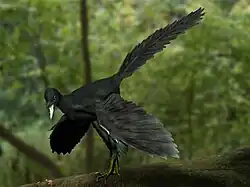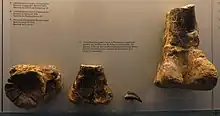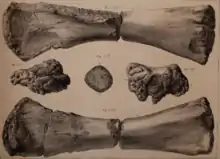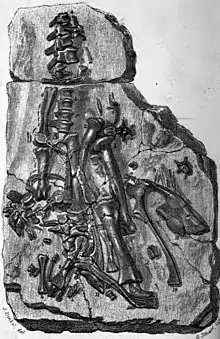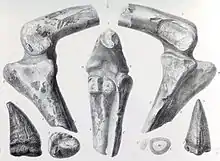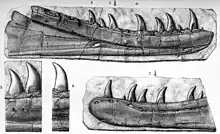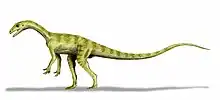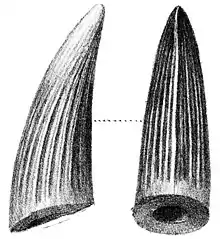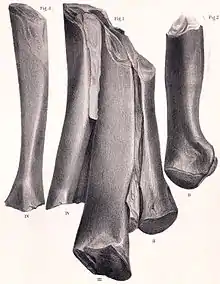List of European dinosaurs
Dinosaurs evolved partway through the Triassic period of the Mesozoic era, around 230 Ma (million years ago). At that time, the earth had one supercontinental landmass, called Pangaea, of which Europe was a part. So it remained throughout the Triassic. By the start of the Jurassic period, some 30 million years later, the supercontinent began to split into Laurasia and Gondwana. The largest inlet from Panthalassa, the superocean that surrounded Pangaea, was called the Tethys Ocean, and as this inlet cut deeper into the supercontinent, much of Europe was flooded.

By the Cretaceous, from 145 to 66 million years ago, the continents were beginning to approach their present shapes, but not their present positions, and Europe remained tropical. At times, it was a chain of island-microcontinents including Baltica and Iberia.
Europe is relatively rich in fossils from the Jurassic-Cretaceous boundary, and much of what is known about European dinosaurs dates from this time. During the Maastrichtian the end of the Cretaceous dinosaurs were dominating western and Central Europe as the Tremp Formation in Spain dates back to that age. Examples of dinosaurs from Maastrichtian Europe are Struthiosaurus and Canardia.
Criteria for inclusion
- The genus must appear on the List of dinosaur genera.
- At least one named species of the creature must have been found in Europe.
- This list is a complement to Category:Mesozoic dinosaurs of Europe.
List of European dinosaurs
Valid genera
| Name | Year | Formation | Location | Notes | Images |
|---|---|---|---|---|---|
| Abditosaurus | 2022 | Tremp Group (Late Cretaceous, Maastrichtian) | Larger and distantly related to other European sauropods, suggesting it was an immigrant from another continent[1] |  | |
| Acanthopholis | 1867 | Chalk Group (Early Cretaceous to Late Cretaceous, Albian to Cenomanian) | Possessed keeled oval scutes as well as long spines |  | |
| Adynomosaurus | 2019 | Tremp Group (Late Cretaceous, Maastrichtian) | Relatively basal despite its late age[2] |  | |
| Aepisaurus | 1852 | Grès vert (Early Cretaceous, Albian) | Known only from a humerus which shares some features with camarasaurids and titanosaurs[3] | 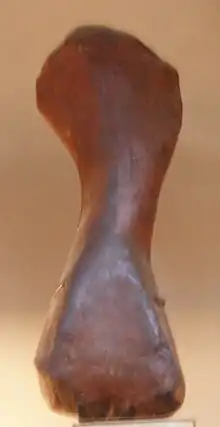 | |
| Ajkaceratops | 2010 | Csehbánya Formation (Late Cretaceous, Santonian) | Its ancestors may have migrated from Asia via island-hopping |  | |
| Allosaurus | 1877 | Lourinhã Formation (Late Jurassic, Kimmeridgian to Tithonian) | Two species, including the type, are known from the United States. The European species may be a synonym of A. fragilis[4] | ||
| Alocodon | 1973 | Cabaços Formation (Late Jurassic, Oxfordian) | Had vertical grooves on its teeth | 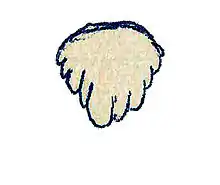 | |
| Altispinax | 1923 | Wadhurst Clay Formation (Early Cretaceous, Valanginian) | Possessed elongated neural spines that may have supported a hump-like structure as in Concavenator |  | |
| Amanzia | 2020 | Reuchenette Formation (Late Jurassic, Kimmeridgian) | One bone preserves fossilized cartilage.[5] Originally believed to be a species of Ornithopsis or Cetiosauriscus |  | |
| Ampelosaurus | 1995 | Grès de Labarre, Gres de Saint-Chinian, Marnes Rouges Inférieures Formation, Villalba de la Sierra Formation (Late Cretaceous, Maastrichtian) | Had three different types of osteoderms, including spines, plates, and bulbs |  | |
| Anoplosaurus | 1879 | Cambridge Greensand (Early Cretaceous, Albian) | Considered an ankylosaur despite the fact no osteoderms have been found. Historically suggested to be an ornithopod | .jpg.webp) | |
| Aragosaurus | 1987 | Villar del Arzobispo Formation (Early Cretaceous, Berriasian) | Reportedly had a unique ischium |  | |
| Arcovenator | 2014 | Argiles et Grès à Reptiles Formation (Late Cretaceous, Campanian) | Most closely related to abelisaurids from India and Madagascar[6] |  | |
| Arenysaurus | 2009 | Tremp Group (Late Cretaceous, Maastrichtian) | One of the last lambeosaurines prior to their extinction |  | |
| Aristosuchus | 1876 | Wealden Group (Early Cretaceous, Barremian) | May have had long claws based on referred unguals |  | |
| Asylosaurus | 2007 | Unnamed fissure fill (Late Triassic, Rhaetian) | Remains originally identified as Thecodontosaurus |  | |
| Atsinganosaurus | 2010 | Argiles et Grès à Reptiles Formation (Late Cretaceous, Maastrichtian) | Belongs to a unique clade of southwestern European titanosaurs[7] |  | |
| Aviatyrannis | 2003 | Alcobaça Formation (Late Jurassic, Oxfordian to Tithonian) | Although related to large tyrannosauroids, members of this genus were very small |  | |
| Barilium | 2010 | Wadhurst Clay (Early Cretaceous, Valanginian) | Robust with strong vertebrae and short neural spines | 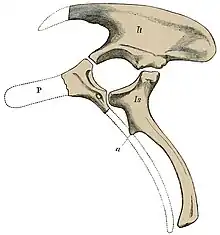 | |
| Baryonyx | 1986 | Weald Clay Formation (Early Cretaceous, Barremian) | One specimen was found with the remains of fish and a juvenile iguanodont in its stomach, suggesting it was a generalist predator[8] |  | |
| Betasuchus | 1932 | Maastricht Formation (Late Cretaceous, Maastrichtian) | The first terrestrial vertebrate named from the Maastrichtian stage[9] | 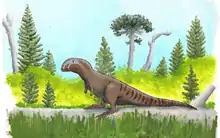 | |
| Blasisaurus | 2010 | Arén Formation (Late Cretaceous, Maastrichtian) | Only known from a partial skull but can be distinguished from contemporary lambeosaurines[10] | 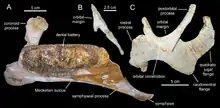 | |
| Bothriospondylus | 1875 | Kimmeridge Clay (Late Jurassic, Kimmeridgian) | Several specimens have been assigned to this genus, but most of them have been reclassified into different genera | 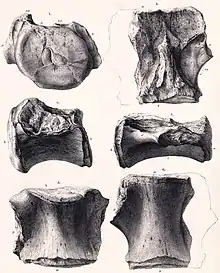 | |
| Bradycneme | 1975 | Sânpetru Formation (Late Cretaceous, Maastrichtian) | Potentially an alvarezsaurid[5] | ||
| Brighstoneus | 2021 | Wessex Formation (Early Cretaceous, Barremian) | Possessed a long snout tipped with a low bump |  | |
| Burianosaurus | 2017 | Peruc-Korycany Formation (Late Cretaceous, Cenomanian) | May be closely allied to the rhabdodontids[11] |  | |
| Calamosaurus | 1891 | Wessex Formation (Early Cretaceous, Barremian) | Only known from two cervical vertebrae. Several bones have been referred to it over the years but there is no way to prove all of them belonged to the same genus | 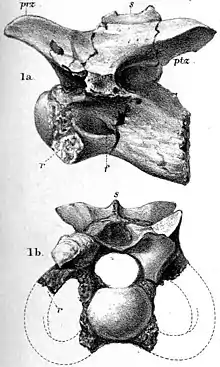 | |
| Calamospondylus | 1866 | Wessex Formation (Early Cretaceous, Hauterivian) | Originally known from only a sacrum and associated pelvic elements | ||
| Callovosaurus | 1980 | Oxford Clay (Middle Jurassic, Callovian) | The oldest known dryosaurid[12] |  | |
| Calvarius | 2023 | Tremp Formation (Early Cretaceous, Maastrichtian) | He was a small dinosaur resembling Hypsilophodon |  | |
| Camarillasaurus | 2014 | Camarillas Formation (Early Cretaceous, Barremian) | Described as a ceratosaur[13] but has since been reinterpreted as a spinosaurid[14] | 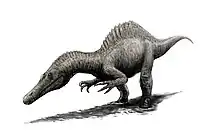 | |
| Camelotia | 1985 | Westbury Formation (Late Triassic to Early Jurassic, Rhaetian to Hettangian) | One of the largest known non-sauropod sauropodomorphs |  | |
| Canardia | 2013 | Marnes d'Auzas Formation (Late Cretaceous, Maastrichtian) | May have been a close relative of Aralosaurus | 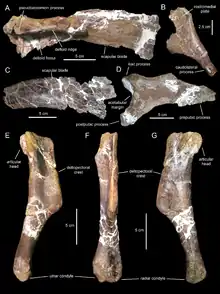 | |
| Cardiodon | 1841 | Forest Marble Formation (Middle Jurassic, Bathonian) | The first sauropod ever named.[15] Known only from a tooth | ||
| Ceratosuchops | 2021 | Wessex Formation (Early Cretaceous, Barremian) | Differs from Baryonyx in subtle details of its skull | 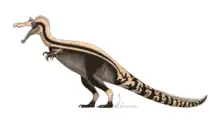 | |
| Cetiosauriscus | 1927 | Oxford Clay (Middle Jurassic, Callovian) | Has been assigned to a variety of positions around Eusauropoda[16][17][18] | 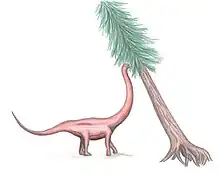 | |
| Cetiosaurus | 1841 | Rutland Formation (Middle Jurassic, Bajocian to Bathonian) | The first sauropod known from decent remains. Once believed to a large seagoing animal | 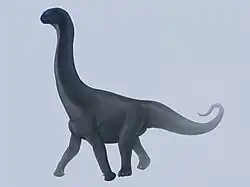 | |
| Chondrosteosaurus | 1876 | Wessex Formation (Early Cretaceous, Barremian) | The air sacs in its vertebrae were originally believed to be filled with cartilage | ||
| Compsognathus | 1859 | Alcobaça Formation?, Portland Stone, Solnhofen Limestone (Late Jurassic, Kimmeridgian to Tithonian) | One of the smallest known non-avian dinosaurs | 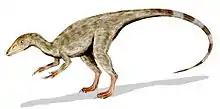 | |
| Concavenator | 2010 | La Huérguina Formation (Early Cretaceous, Barremian) | Preserves bumps on its ulna which have been interpreted as quill knobs,[19] although they might have been muscle attachments instead[20] |  | |
| Craspedodon | 1883 | Unnamed formation (Late Cretaceous, Santonian) | May be the first neoceratopsian known from Europe[21] | 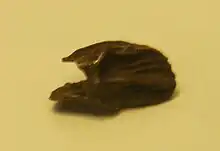 | |
| Craterosaurus | 1874 | Woburn Sands Formation (Early Cretaceous, Aptian to Albian) | Potentially synonymous with Regnosaurus | 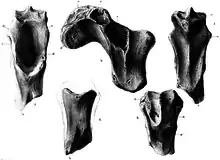 | |
| Cruxicheiros | 2010 | Chipping Norton Limestone (Middle Jurassic, Bathonian) | Inconsistent in phylogenetic placement |  | |
| Cryptosaurus | 1869 | Ampthill Clay (Late Jurassic, Oxfordian) | Only known from a single femur | 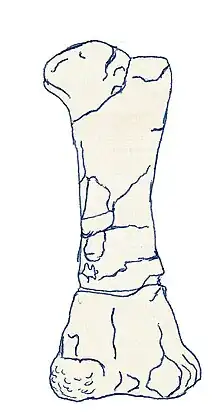 | |
| Cumnoria | 1888 | Kimmeridge Clay (Late Jurassic, Kimmeridgian) | May be a species of Camptosaurus[22] | 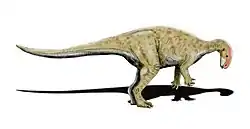 | |
| Dacentrurus | 1902 | Alcobaça Formation, Argiles d'Octeville, Kimmeridge Clay, Lourinhã Formation, Villar del Arzobispo Formation (Late Jurassic to Early Cretaceous, Kimmeridgian to Berriasian) | Known from abundant remains. Lived in a broad range |  | |
| Demandasaurus | 2011 | Castrillo de la Reina Formation (Early Cretaceous, Barremian to Aptian) | Most closely related to African rebbachisaurids, suggesting a faunal exchange[23] |  | |
| Dinodocus | 1884 | Lower Greensand Group (Early Cretaceous, Barremian) | The only known humerus is almost complete, missing only small portions |  | |
| Dolichosuchus | 1932 | Löwenstein Formation (Late Triassic, Norian) | Originally classified as a stem-crocodile |  | |
| Draconyx | 2001 | Lourinhã Formation (Late Jurassic, Tithonian) | May have been closely related to Camptosaurus[24] |  | |
| Dracopelta | 1980 | Lourinhã Formation (Late Jurassic, Tithonian) | The structure of its limbs suggest it might have had a cursorial lifestyle[25] | ||
| Dracoraptor | 2016 | Lias Group (Early Jurassic, Hettangian) | May have been a shore dweller due to its island habitat[26] |  | |
| Dromaeosauroides | 2003 | Jydegaard Formation (Early Cretaceous, Berriasian) | A referred coprolite has been found which contains fish remains, but it could instead belong to a turtle[27] | 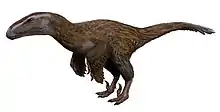 | |
| Dubreuillosaurus | 2005 | Calcaire de Caen (Middle Jurassic, Bathonian) | Would have lived in a coastal mangrove swamp |  | |
| Duriatitan | 2010 | Kimmeridge Clay (Late Jurassic, Kimmeridgian) | Originally named as a species of Cetiosaurus | 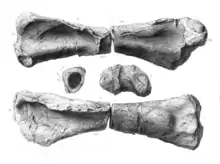 | |
| Duriavenator | 2008 | Inferior Oolite (Middle Jurassic, Bajocian) | The most basal known member of the Megalosaurinae, which aligns with its stratigraphic position[28] |  | |
| Echinodon | 1861 | Purbeck Group (Early Cretaceous, Berriasian) | Originally misidentified as a herbivorous lizard |  | |
| Efraasia | 1973 | Löwenstein Formation (Late Triassic, Norian) | Some remains assigned to this genus were originally classified in separate genera |  | |
| Elopteryx | 1913 | Sânpetru Formation (Late Cretaceous, Maastrichtian) | May be closely related to Balaur and Gargantuavis[29] |  | |
| Emausaurus | 1990 | Ciechocinek Formation (Early Jurassic, Toarcian) | One of the oldest and most basal thyreophorans |  | |
| Eotyrannus | 2001 | Wessex Formation (Early Cretaceous, Barremian) | Possessed grasping hands with three long fingers |  | |
| Eousdryosaurus | 2014 | Lourinhã Formation (Late Jurassic, Kimmeridgian) | Described as a dryosaurid[30] but one study suggests a close relationship with elasmarians[31] | ||
| Erectopus | 1923 | La Penthiève Beds (Early Cretaceous, Albian) | One of the youngest known European carnosaurs | 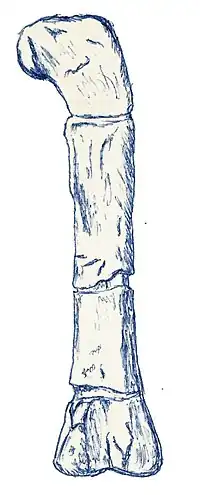 | |
| Eucamerotus | 1872 | Wessex Formation (Early Cretaceous, Barremian) | Preserves extensive evidence of pneumatization | ||
| Eucercosaurus | 1879 | Cambridge Greensand (Early Cretaceous, Albian) | Sometimes considered an ankylosaur but one study assigns it to Iguanodontia[32] | ||
| Euronychodon | 1991 | Argiles et sables de Taveiro (Late Cretaceous, Campanian to Maastrichtian) | Only known from teeth. Another species has been found in Uzbekistan | ||
| Europasaurus | 2006 | Süntel Formation (Late Jurassic, Oxfordian to Kimmeridgian) | Much smaller than other sauropods due to its isolated island habitat[33] | 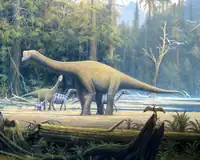 | |
| Europatitan | 2017 | Castrillo de la Reina Formation (Early Cretaceous, Barremian to Aptian) | Some of this genus' remains include several vertebrae. The specific name, E. eastwoodi, honors director Clint Eastwood |  | |
| Europelta | 2013 | Escucha Formation (Early Cretaceous, Albian) | Almost the entire skeleton is known |  | |
| Eustreptospondylus | 1964 | Oxford Clay (Late Jurassic, Oxfordian) | May have swum between islands similar to a Komodo dragon[34] | 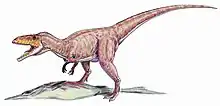 | |
| Fylax | 2021 | Figuerola Formation (Late Cretaceous, Maastrichtian) | Lived very late despite its comparatively basal position[35] |  | |
| Galvesaurus | 2005 | Villar del Arzobispo Formation (Late Jurassic, Kimmeridgian to Tithonian) | Also spelled Galveosaurus. Two sets of paleontologists named the same fossil seemingly unaware of each other's work, although there is evidence that one of them had plaigiarized the others, but misspelled the name[36] |  | |
| Garrigatitan | 2021 | Argiles et Grès à Reptiles Formation (Late Cretaceous, Campanian) | Known from remains of both adults and subadults | ||
| Genusaurus | 1995 | Bevons Beds (Early Cretaceous, Albian) | Has been suggested to be either a noasaurid[37] or an abelisaurid[38] | ||
| Gideonmantellia | 2012 | Camarillas Formation (Early Cretaceous, Barremian) | Originally misidentified as a specimen of Hypsilophodon |  | |
| Gigantosaurus | 1869 | Kimmeridge Clay (Late Jurassic, Kimmeridgian) | May have possessed osteoderms |  | |
| Haestasaurus | 2015 | Hastings Beds (Early Cretaceous, Berriasian to Valanginian) | Preserves impressions of differently-sized hexagonal scales | 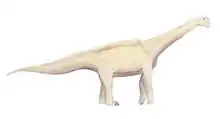 | |
| Halticosaurus | 1952 | Löwenstein Formation (Late Triassic, Norian) | Historically conflated with the bones of unrelated animals | ||
| Heptasteornis | 1975 | Sânpetru Formation (Late Cretaceous, Maastrichtian) | Once believed to be a giant prehistoric owl | 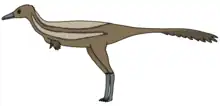 | |
| Histriasaurus | 1998 | Unnamed formation (Early Cretaceous, Hauterivian to Barremian) | Despite being discovered in Europe, it may have lived between southern Europe and Africa in life[39] |  | |
| Horshamosaurus | 2015 | Weald Clay (Early Cretaceous, Barremian) | A supposed tibia has been reinterpreted as an ischium[40] |  | |
| Hungarosaurus | 2005 | Csehbánya Formation (Late Cretaceous, Santonian) | Possessed an elevated shoulder which may be an adaptation to high-browsing[41] | 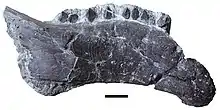 | |
| Hylaeosaurus | 1833 | Grinstead Clay Formation?, Tunbridge Wells Sand Formation (Early Cretaceous, Valanginian) | One of the three animals originally used to define the Dinosauria, along with Iguanodon and Megalosaurus | 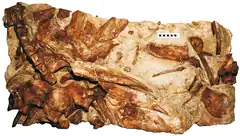 | |
| Hypselosaurus | 1869 | Argiles et Grès à Reptiles Formation (Late Cretaceous, Maastrichtian) | Several spherical eggs have been attributed to this taxon |  | |
| Hypselospinus | 2010 | Wadhurst Clay (Early Cretaceous, Valanginian) | Had elongated neural spines projecting from the top of its vertebrae | 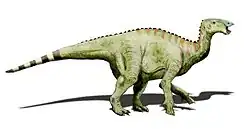 | |
| Hypsilophodon | 1869 | Wessex Formation (Early Cretaceous, Hauterivian to Barremian) | May have been a deer-like low browser that fed on young shoots and roots |  | |
| Iberospinus | 2022 | Papo Seco Formation (Early Cretaceous, Barremian) | Basal yet already displays some adaptations for a semiaquatic lifestyle | 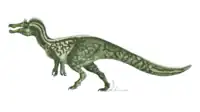 | |
| Iguanodon | 1825 | Arcillas de Morella Formation, Camarillas Formation, Lower Greensand Group, Sainte-Barbe Clays Formation, Wadhurst Clay, Weald Clay, Wealden Formation, Wessex Formation (Early Cretaceous, Barremian to Aptian) | Multiple remains are known which make it one of the best known dinosaurs | 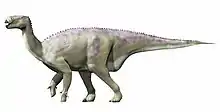 | |
| Iliosuchus | 1932 | Stonesfield Slate (Middle Jurassic, Bathonian) | Only known from three ilia |  | |
| Iuticosaurus | 1993 | Upper Greensand Formation, Wessex Formation (Early Cretaceous, Hauterivian to Barremian) | Two species have been named, each from a single caudal vertebra |  | |
| Juratyrant | 2013 | Kimmeridge Clay (Late Jurassic, Tithonian) | Originally named as a species of Stokesosaurus | 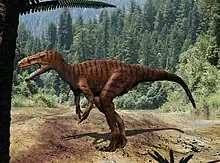 | |
| Juravenator | 2006 | Painten Formation (Late Jurassic, Kimmeridgian) | Impressions of both scales and feathers are known. The tail preserves structures that may be integumentary sense organs like those of crocodiles, which it may have used to hunt for fish at night[42] |  | |
| Lexovisaurus | 1957 | Oxford Clay (Middle Jurassic, Callovian) | Its pelvis was greatly enlarged | 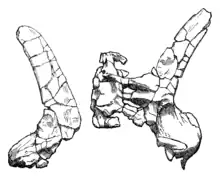 | |
| Liliensternus | 1984 | Trossingen Formation (Late Triassic, Norian to Rhaetian) | Although commonly depicted with a head crest, there is no evidence for such a feature | 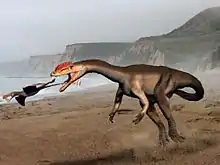 | |
| Lirainosaurus | 1999 | Marnes Rouges Inférieures Formation?, Sierra Perenchiza Formation, Sobrepena Formation (Late Cretaceous, Campanian to Maastrichtian) | For a titanosaur, it was small and had a relatively gracile build | 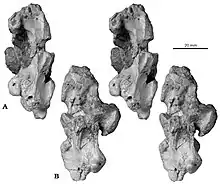 | |
| Lohuecotitan | 2016 | Villalba de la Sierra Formation (Late Cretaceous, Campanian to Maastrichtian) | May have had "bulb-and-root"-type osteoderms, which are abundant at the type locality[43] |  | |
| Lophostropheus | 2007 | Moon-Airel Formation (Late Triassic to Early Jurassic, Rhaetian to Hettangian) | The only substantially well-known theropod from the Triassic-Jurassic boundary[44] | ||
| Loricatosaurus | 2008 | Marnes a Belemnopsis latesulcatus Formation, Oxford Clay (Middle Jurassic, Callovian) | Had narrow, flat plates on its back and round, pointed spines that ran along the tail |  | |
| Losillasaurus | 2001 | Villar del Arzobispo Formation (Late Jurassic, Kimmeridgian) | Was heterodont, having four types of teeth, one of which was heart-shaped[45] |  | |
| Lourinhanosaurus | 1998 | Lourinhã Formation (Late Jurassic, Kimmeridgian to Tithonian) | More than one hundred eggs have been referred to this taxon |  | |
| Lourinhasaurus | 1998 | Lourinhã Formation (Late Jurassic, Kimmeridgian) | Closely related to Camarasaurus but with proportionately longer forelimbs |  | |
| Lusitanosaurus | 1957 | Unknown formation (Early Jurassic, Sinemurian) | Poorly known but evidently large for a basal thyreophoran |  | |
| Lusotitan | 2003 | Lourinhã Formation (Late Jurassic, Kimmeridgian to Tithonian) | Originally named as a European species of Brachiosaurus |  | |
| Lusovenator | 2020 | Lourinhã Formation (Late Jurassic to Early Cretaceous, Kimmeridgian to Berriasian) | The oldest carcharodontosaurian known from Eurasia |  | |
| Macrurosaurus | 1869 | Cambridge Greensand, Chalk Group? (Early Cretaceous, Albian) | Only known from a series of caudal vertebrae |  | |
| Magnamanus | 2016 | Golmayo Formation (Early Cretaceous, Hauterivian to Barremian) | Possessed relatively enlarged hands | ||
| Magnosaurus | 1932 | Inferior Oolite (Middle Jurassic, Bajocian) | Confusingly, a referred specimen was simultaneously named as a species of this genus and of Sarcosaurus |  | |
| Magyarosaurus | 1932 | Sânpetru Formation (Late Cretaceous, Maastrichtian) | An insular dwarf titanosaur that was one of the smallest of its group |  | |
| Mantellisaurus | 2007 | Arcillas de Morella Formation, Lower Greensand Group, Sainte-Barbe Clays Formation, Vectis Formation, Wessex Formation (Early Cretaceous, Barremian to Aptian) | Several specimens are known. Distinguishable from the contemporary Iguanodon by its more gracile build |  | |
| Marmarospondylus | 1875 | Forest Marble Formation (Middle Jurassic, Bathonian) | Usually assigned to the genus Bothriospondylus, but this cannot be confirmed |  | |
| Matheronodon | 2017 | Argiles et Grès à Reptiles Formation (Late Cretaceous, Campanian) | Had extremely specialized dentition that may have been an adaptation to feeding on tough monocot plants[46] | 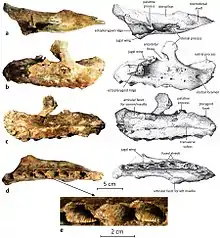 | |
| Megalosaurus | 1824 | Chipping Norton Limestone Formation, Taynton Limestone Formation (Middle Jurassic, Bathonian) | The first non-avian dinosaur scientifically named and described | 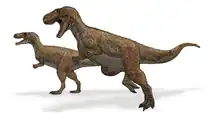 | |
| Metriacanthosaurus | 1964 | Oxford Clay (Late Jurassic, Oxfordian) | Possessed relatively tall neural spines for a carnosaur | 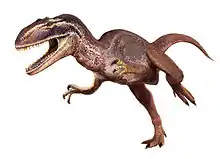 | |
| Miragaia | 2009 | Lourinhã Formation (Late Jurassic, Kimmeridgian to Tithonian) | Had an extremely elongated neck made up of seventeen vertebrae | 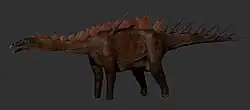 | |
| Mochlodon | 1881 | Csehbánya Formation, Gosau Group (Late Cretaceous, Santonian to Campanian) | Originally named as a species of Iguanodon | 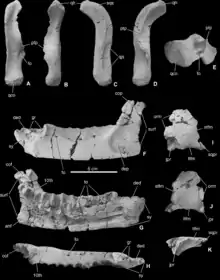 | |
| Morelladon | 2015 | Arcillas de Morella Formation (Early Cretaceous, Barremian) | Possessed a low sail on its back supported by elongated neural spines | 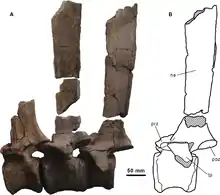 | |
| Morinosaurus | 1874 | Unnamed formation (Late Jurassic, Kimmeridgian) | Poorly known | ||
| Neosodon | 1885 | Sables et Grès a Trigonia gibbosa (Late Jurassic, Tithonian) | No species are assigned to this genus. Popularly associated with "Iguanodon" praecursor but is in fact a separate taxon[47] | 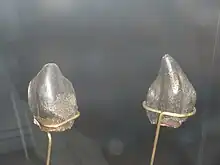 | |
| Neovenator | 1996 | Wessex Formation (Early Cretaceous, Hauterivian to Barremian) | Had a complex series of neurovascular canals lining its snout[48] | 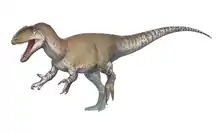 | |
| Normanniasaurus | 2013 | Poudingue Ferrugineux (Early Cretaceous, Albian) | Represents a European radiation of basal titanosaurs[49] | ||
| Notatesseraeraptor | 2019 | Klettgau Formation (Late Triassic, Norian) | Combines features of different groups of basal theropods |  | |
| Nuthetes | 1854 | Lulworth Formation (Early Cretaceous, Berriasian) | Only known from jaws and teeth. Traditionally identified as a dromaeosaurid but it might be a proceratosaurid instead[50] |  | |
| Oceanotitan | 2019 | Lourinhã Formation (Late Jurassic, Tithonian) | Potentially the oldest known somphospondylian[51] |  | |
| Ohmdenosaurus | 1978 | Posidonia Shale (Early Jurassic, Toarcian) | Originally misidentified as a plesiosaur | 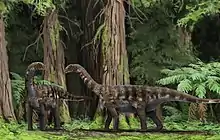 | |
| Oligosaurus | 1881 | Gosau Group (Late Cretaceous, Campanian) | May be synonymous with another genus of rhabdodontid | ||
| Oplosaurus | 1852 | Wessex Formation (Early Cretaceous, Barremian) | The holotype tooth was pointed, which led to its misidentification as a carnivorous reptile[52] | 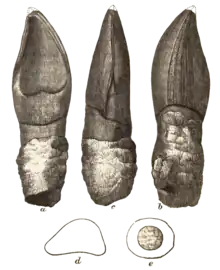 | |
| Ornithodesmus | 1887 | Wessex Formation (Early Cretaceous, Barremian) | Historically conflated with the remains of the pterosaur Istiodactylus | 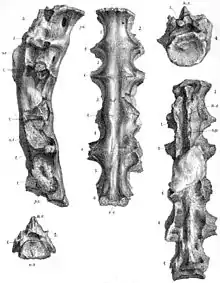 | |
| Ornithomerus | 1881 | Gosau Group (Late Cretaceous, Campanian) | May be synonymous with another genus of rhabdodontid | ||
| Ornithopsis | 1870 | Wealden Formation (Early Cretaceous, Barremian) | Originally believed to be an intermediate form between birds, pterosaurs, and dinosaurs |  | |
| Orthomerus | 1883 | Maastricht Formation (Late Cretaceous, Maastrichtian) | Potentially dubious and undiagnostic[53] | 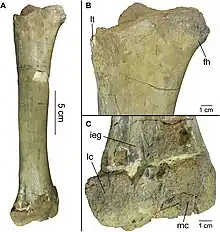 | |
| Ostromia | 2017 | Painten Formation (Late Jurassic, Tithonian) | Considered a small pterosaur until it was redescribed as a specimen of Archaeopteryx in 1970.[54] Some of its features are similar to those of Anchiornis | 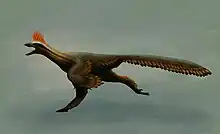 | |
| Owenodon | 2009 | Purbeck Limestone (Early Cretaceous, Berriasian) | Has been assigned to Iguanodon and Camptosaurus before it received its own genus |  | |
| Paludititan | 2010 | Sânpetru Formation (Late Cretaceous, Maastrichtian) | Some of its bones are identical to those of Magyarosaurus, but their synonymy cannot be confirmed |  | |
| Pararhabdodon | 1993 | Tremp Group (Late Cretaceous, Maastrichtian) | The first lambeosaurine identified from Europe |  | |
| Pareisactus | 2019 | Tremp Group (Late Cretaceous, Maastrichtian) | Represented by a single scapula recovered from a hadrosaur bonebed |  | |
| Pelecanimimus | 1994 | La Huérguina Formation (Early Cretaceous, Barremian) | Preserves extensive soft tissue impressions revealing the presence of a keratinous head crest and a pelican-like gular pouch |  | |
| Pelorosaurus | 1850 | Tunbridge Wells Sand Formation (Early Cretaceous, Hauterivian) | The first sauropod identified as a terrestrial animal | 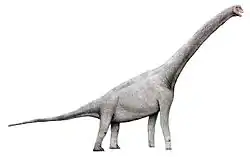 | |
| Pendraig | 2021 | Pant-y-Ffynnon Quarry (Late Triassic, Norian to Rhaetian) | Would have lived on a dry limestone island[55] | 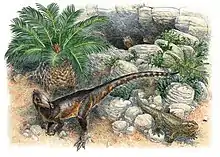 | |
| Phyllodon | 1973 | Alcobaça Formation (Late Jurassic, Kimmeridgian) | The front and back sides of its teeth were asymmetrical | 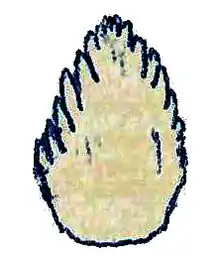 | |
| Piveteausaurus | 1977 | Marnes de Dives Formation (Middle Jurassic, Callovian) | Has been suggested to be a species of Proceratosaurus |  | |
| Plateosaurus | 1837 | Klettgau Formation, Löwenstein Formation, Lunde Formation, Trossingen Formation (Late Triassic, Norian to Rhaetian) | Known from over a hundred skeletons, several of them nearly complete |  | |
| Pneumatoraptor | 2010 | Csehbánya Formation (Late Cretaceous, Santonian) | One study suggests a position as a possible early palaeognath[56] |  | |
| Poekilopleuron | 1836 | Calcaire de Caen (Middle Jurassic, Bathonian) | Its holotype was found alongside fish remains[57] | 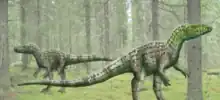 | |
| Polacanthus | 1865 | Wessex Formation (Early Cretaceous, Barremian) | Possessed a flat sacral shield dotted with small bumps |  | |
| Portellsaurus | 2021 | Margas de Mirambell Formation (Early Cretaceous, Barremian) | Closely related to Ouranosaurus[58] |  | |
| Priodontognathus | 1875 | Lower Calcareous Grit (Late Jurassic, Oxfordian) | Only known from a single maxilla with teeth | ||
| Proa | 2012 | Escucha Formation (Early Cretaceous, Albian) | The tip of its jaw was shaped like the bow of a ship |  | |
| Proceratosaurus | 1926 | Great Oolite Group (Middle Jurassic, Bathonian) | Preserves a small horn on its snout which may have anchored a crest as in the related Guanlong | 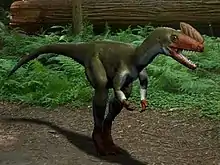 | |
| Procompsognathus | 1913 | Löwenstein Formation (Late Triassic, Norian) | Has been suggested to be non-dinosaurian |  | |
| Protathlitis | 2023 | Arcillas de Morella Formation (Early Cretaceous, Barremian) | A large baryonchine and one of several unique Early Cretaceous spinosaurids from the Iberian Peninsula[59] |  | |
| Pterospondylus | 1913 | Trossingen Formation (Late Triassic, Norian) | Known from only a single, large vertebra |  | |
| Pyroraptor | 2000 | Argiles et Grès à Reptiles Formation (Late Cretaceous, Campanian to Maastrichtian) | Its holotype specimen was exposed by a forest fire | 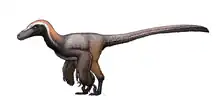 | |
| Regnosaurus | 1848 | Tunbridge Wells Sand Formation (Early Cretaceous, Berriasian to Valanginian) | Potentially a stegosaur similar to Huayangosaurus[60] | 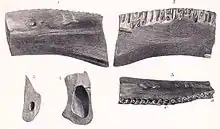 | |
| Rhabdodon | 1869 | Gres de Labarre Formation, Gres de Saint-Chinian, Marnes Rouges Inférieures Formation, Villalba de la Sierra Formation (Late Cretaceous, Campanian to Maastrichtian) | Although most rhabdodontids are insular dwarfs, this genus may represent an instance of island gigantism as it is much larger than other members of its family[61] |  | |
| Riabininohadros | 2020 | Unnamed formation (Late Cretaceous, Maastrichtian) | Possessed a femur so unique it has no morphological equivalents across all of Iguanodontia |  | |
| Riparovenator | 2021 | Wessex Formation (Early Cretaceous, Barremian) | Had elongated spines projecting from its caudal vertebrae somewhat similar to those of Spinosaurus | 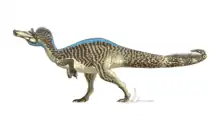 | |
| Ruehleia | 2001 | Trossingen Formation (Late Triassic, Norian) | Known from a single, nearly complete skeleton |  | |
| Saltriovenator | 2018 | Saltrio Formation (Early Jurassic, Sinemurian) | The biggest and oldest theropod from the Early Jurassic yet known |  | |
| Sarcolestes | 1893 | Oxford Clay (Middle Jurassic, Callovian) | Originally misidentified as a carnivorous dinosaur |  | |
| Sarcosaurus | 1921 | Lias Group (Early Jurassic, Hettangian to Sinemurian) | Has been variously suggested to be a coelophysoid,[62] a ceratosaur,[63] a dilophosaurid,[64] and a more basal neotheropod[65] |  | |
| Scelidosaurus | 1859 | Lias Group (Early Jurassic, Sinemurian to Pliensbachian) | Carried hundreds of small osteoderms in several rows along its back |  | |
| Schleitheimia | 2020 | Klettgau Formation (Late Triassic, Norian) | Possessed a relatively enlarged ilium | ||
| Scipionyx | 1998 | Pietraroja Plattenkalk (Early Cretaceous, Albian) | So well preserved that several internal organs and their positions in life could be accurately reconstructed |  | |
| Sciurumimus | 2012 | Unnamed formation (Late Jurassic, Tithonian) | Had a bushy tail similar to that of a squirrel |  | |
| Soriatitan | 2017 | Golmayo Formation (Early Cretaceous, Valanginian to Hauterivian) | The first confirmed brachiosaurid known from Early Cretaceous Europe |  | |
| Stenopelix | 1857 | Obernkirchen Sandstein Formation (Early Cretaceous, Berriasian) | Possibly closely related to basal ceratopsians from Late Jurassic China[66] |  | |
| Streptospondylus | 1832 | Marnes de Dives/Marnes de Villers? (Middle Jurassic to Late Jurassic, Callovian to Oxfordian) | Originally believed to represent a marine crocodile | 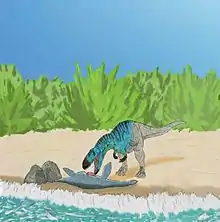 | |
| Struthiosaurus | 1871 | Argiles et Grès à Reptiles Formation, Gosau Group, Sânpetru Formation (Late Cretaceous, Santonian to Maastrichtian) | Analysis of its braincase suggests poor hearing and a sluggish, solitary lifestyle[67] |  | |
| Syngonosaurus | 1879 | Cambridge Greensand (Early Cretaceous, Albian) | Usually considered a synonym of Acanthopholis but it has been reinterpreted as an iguanodont[32] |  | |
| Tamarro | 2021 | Tremp Group (Late Cretaceous, Maastrichtian) | May have been closely related to Asian troodontids[68] |  | |
| Tanystrosuchus | 1963 | Löwenstein Formation (Late Triassic, Norian) | The only known vertebra was once misidentified as a phytosaur | ||
| Tarascosaurus | 1991 | Fuvelian Beds (Late Cretaceous, Campanian) | If an abelisaurid it would be one of the few northern members of the group | .jpg.webp) | |
| Tastavinsaurus | 2008 | Forcall Formation, Xert Formation (Early Cretaceous, Barremian) | Could represent an obscure group of macronarians called Laurasiformes[69] |  | |
| Taveirosaurus | 1991 | Argilas de Aveiro Formation (Late Cretaceous, Maastrichtian) | Only known from teeth | ||
| Teinurosaurus | 1928 | Mont-Lambert Formation (Late Jurassic, Tithonian) | Poorly known |  | |
| Telmatosaurus | 1903 | Sânpetru Formation (Late Cretaceous, Maastrichtian) | One specimen preserves a facial deformity caused by an ameloblastoma[70] | 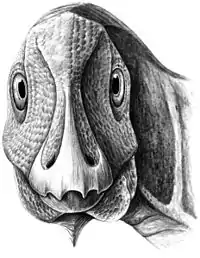 | |
| Tethyshadros | 2009 | Liburnia Formation (Late Cretaceous, Campanian) | Had limbs adapted for high speed but were too short for running[41] | 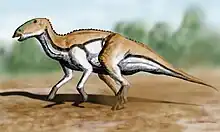 | |
| Thecocoelurus | 1923 | Wessex Formation (Early Cretaceous, Barremian) | Has been assigned to a variety of theropod groups throughout history |  | |
| Thecodontosaurus | 1836 | Magnesian Conglomerate (Late Triassic, Rhaetian) | Remains of this genus are often found in Carboniferous-aged fissure fills |  | |
| Thecospondylus | 1882 | Hastings Beds (Early Cretaceous, Valanginian to Hauterivian) | Indeterminate within Dinosauria |  | |
| Torvosaurus | 1979 | Kimmeridge Clay?, Lourinhã Formation, Ornatenton Formation (Middle Jurassic to Late Jurassic, Callovian to Tithonian) | The type species was found in the United States. Several species lived around the world, including in Europe, but T. gurneyi is the only non-American species a formal name. It represents Europe's largest terrestrial predator[71] |  | |
| Transylvanosaurus | 2022 | Pui Beds (Late Cretaceous, Maastrichtian) | Had an unusually wide skull compared to other rhabdodontids | ||
| Trimucrodon | 1973 | Lourinha Formation (Late Jurassic, Kimmeridgian) | Similarities have been noted with Alocodon and Taveirosaurus[72] | ||
| Tuebingosaurus | 2022 | Trossingen Formation (Late Triassic, Norian) | Although originally assigned to Plateosaurus, it contains several features that point to a more derived position |  | |
| Turiasaurus | 2006 | Villar del Arzobispo Formation (Late Jurassic, Kimmeridgian to Tithonian) | Extremely large despite not being a member of Neosauropoda | 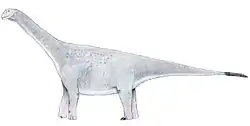 | |
| Valdosaurus | 1977 | Hastings Beds, Tunbridge Wells Sand Formation, Weald Clay, Wessex Formation (Early Cretaceous, Berriasian to Barremian) | Large and similar to Dryosaurus |  | |
| Vallibonavenatrix | 2019 | Arcillas de Morella Formation (Early Cretaceous, Barremian) | One of the most complete spinosaurids known from Iberia | 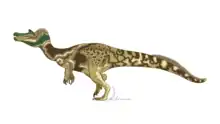 | |
| Variraptor | 1998 | Argiles et Grès à Reptiles Formation (Late Cretaceous, Campanian to Maastrichtian) | May be closely related to Bambiraptor[56] |  | |
| Vectaerovenator | 2020 | Ferruginous Sands (Early Cretaceous, Aptian) | Only known from four vertebrae but are distinct enough to be classified as their own genus |  | |
| Vectiraptor | 2021 | Wessex Formation (Early Cretaceous, Barremian) | Shares some features with North American dromaeosaurids |  | |
| Velocipes | 1932 | Lissauer Breccia (Late Triassic, Norian) | Has been considered a dubious, indeterminate vertebrate[73] |  | |
| Volgatitan | 2018 | Unnamed formation (Early Cretaceous, Hauterivian) | Closely related to South American titanosaurs |  | |
| Vouivria | 2017 | Calcaires de Clerval (Late Jurassic, Oxfordian) | The oldest known titanosauriform | 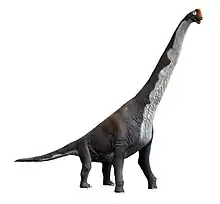 | |
| Wiehenvenator | 2016 | Ornatenton Formation (Middle Jurassic, Callovian) | Before its formal description, it had been nicknamed "the Monster of Minden" |  | |
| Xenoposeidon | 2007 | Hastings Beds (Early Cretaceous, Berriasian to Valanginian) | Only known from a single, very unique vertebra |  | |
| Yaverlandia | 1971 | Vectis Formation?, Wessex Formation (Early Cretaceous, Barremian) | Originally misidentified as a pachycephalosaur because of its thick skull roof |  | |
| Zalmoxes | 2003 | Densus-Ciula Formation, Sânpetru Formation, Sebes Formation (Late Cretaceous, Maastrichtian) | Two species of contrasting sizes have been named | 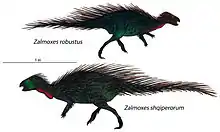 | |
| Zby | 2014 | Lourinhã Formation (Late Jurassic, Kimmeridgian) | Originally believed to be a specimen of Turiasaurus | 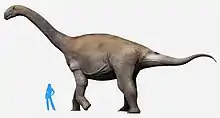 |
Invalid and potentially valid genera
- Agrosaurus macgillivrayi: Originally mistakenly thought to be from Australia. It is now thought to be more likely from England, and possibly a synonym of Thecodontosaurus.
- Archaeopteryx: A well-known taxon that combines bird-like pennaceous feathers with the teeth, claws, and long tail of reptiles. It is usually considered a basal avialan but it might also be a non-avian deinonychosaur closely related to dromaeosaurids.
- Balaur bondoc: A strange paravian that possessed a suite of unique features, such as robust muscles, two sickle claws, a didactyl manus, and a deep gut. It may have been an island-dwelling herbivore or omnivore. Studies show it either as a velociraptorine dromaeosaurid or a basal avialan.
- "Bihariosaurus bauxiticus": Although sometimes presented as a valid taxon, it is actually a nomen nudum.
- Ceratosaurus: Some specimens, mostly teeth, from Portugal and Switzerland have been assigned to this genus, but not to a specific species.
- Darwinsaurus evolutionis: May be a synonym of either Hypselospinus or Mantellisaurus.
- Delapparentia turolensis: Said to be indistinguishable from Iguanodon.
- Dinheirosaurus lourinhanensis: Possibly a second species of Supersaurus.
- Gresslyosaurus: Often thought to be synonymous with Plateosaurus, although several differences between them have been noted.
- Huxleysaurus hollingtoniensis: Potentially a synonym of Hypselospinus.
- "Ischyrosaurus": The generic name Ischyrosaurus is preoccupied. The dinosaur may be a synonym of Ornithopsis.
- Koutalisaurus kohlerorum: Usually seen as a synonym of Pararhabdodon, but it could also be its own taxon.
- Kukufeldia tilgatensis: May be a synonym of Barilium.
- "Liassaurus huenei": Could potentially be a second specimen of Sarcosaurus.
- Mantellodon carpenteri: Known from a single specimen from Maidstone affectionally nicknamed a "Mantell-piece". While originally thought to be a specimen of Iguanodon, it may in fact be a synonym of Mantellisaurus.
- "Merosaurus newmani": Originally referred to Scelidosaurus, but it appears to be a theropod. This name remains informal.
- "Newtonsaurus" cambrensis: Said to be an early theropod, but it may be indeterminate within Archosauria.
- Pantydraco caducus: Originally named as a species of Thecodontosaurus, and indeed it may belong to that genus.
- Polacanthoides ponderosus: Potentially a synonym of Hylaeosaurus, Polacanthus or both (a chimera).
- Proplanicoxa galtoni: May be a junior synonym of Mantellisaurus.
- Rhadinosaurus alcimus: Suggested to be synonymous with Struthiosaurus, but it might have been a crocodilian instead.
- Sellacoxa pauli: Possibly synonymous with Barilium.
- Stegosaurus: Some bones from Portugal have been assigned to this genus, but not to a particular species.
- Suchosaurus: Two species have been named, both from teeth. They are indistinguishable from those of baryonychines and may in fact belong to Baryonyx.
- Therosaurus: This genus was named to accommodate the original type species of Iguanodon, I. anglicus. However, it was named before the type species was transferred to I. bernissartensis, so it remains a junior synonym of Iguanodon.
- Valdoraptor oweni: Potentially a junior synonym of Thecocoelurus.
- Wellnhoferia grandis: May be another specimen of Archaeopteryx.
Timeline
This is a timeline of selected dinosaurs from the list above. Time is measured in Ma, megaannum, along the x-axis.

See also
- Category: Cretaceous paleontological sites of Europe
- List of European birds
- List of dinosaur finds in the United Kingdom
Notes
- Vila, Bernat; Sellés, Albert; Moreno-Azanza, Miguel; Razzolini, Novella L.; Gil-Delgado, Alejandro; Canudo, José Ignacio; Galobart, Àngel (2022). "A titanosaurian sauropod with Gondwanan affinities in the latest Cretaceous of Europe". Nature Ecology & Evolution. 6 (3): 288–296. doi:10.1038/s41559-021-01651-5. PMID 35132183. S2CID 246650381.
- Prieto-Márquez, Albert; Fondevilla, Víctor; Sellés, Albert G.; Wagner, Jonathan R.; Galobart, Àngel (2018). "Adynomosaurus arcanus, a new lambeosaurine dinosaur from the Late Cretaceous Ibero-Armorican Island of the European Archipelago". Cretaceous Research. 96: 19–37. doi:10.1016/j.cretres.2018.12.002. S2CID 134582286.
- Le Loeuff, J. (1993). European titanosaurids. Revue de Paléobiologie, Volume Spéciale 7:105-117.
- Malafaia, Elisabete; Dantas, Pedro; Ortega, Francisco; Escaso, Fernando (2007). "Nuevos restos de Allosaurus fragilis (Theropoda: Carnosauria) del yacimiento de Andrés (Jurásico Superior; centro-oeste de Portugal)" [New remains of Allosaurus fragilis (Theropoda: Carnosauria) of the Andrés deposit (Upper Jurassic; central-west Portugal)] (PDF). Cantera Paleontológica (in Spanish and English): 255–271.
- Holtz, Thomas R. (2012). "Dinosaurs: The Most Complete, Up-to-Date Encyclopedia for Dinosaur Lovers of All Ages" (PDF). University of Maryland.
- Tortosa, Thierry; Eric Buffetaut; Nicolas Vialle; Yves Dutour; Eric Turini; Gilles Cheylan (2014). "A new abelisaurid dinosaur from the Late Cretaceous of southern France: Palaeobiogeographical implications". Annales de Paléontologie. 100 (1): 63–86. Bibcode:2014AnPal.100...63T. doi:10.1016/j.annpal.2013.10.003.
- Verónica Díez Díaz; Géraldine Garcia; Xabier Pereda Suberbiola; Benjamin Jentgen-Ceschino; Koen Stein; Pascal Godefroit; Xavier Valentin (2018). The titanosaurian dinosaur Atsinganosaurus velauciensis (Sauropoda) from the Upper Cretaceous of southern France: New material, phylogenetic affinities, and palaeobiogeographical implications. Cretaceous Research. in press. doi:10.1016/j.cretres.2018.06.015.
- Charig, A. J.; Milner, A. C. (1997). "Baryonyx walkeri, a fish-eating dinosaur from the Wealden of Surrey". Bulletin of the Natural History Museum of London. 53: 11–70.
- Zoltan Csiki-Sava, Eric Buffetaut, Attila Ősi, Xabier Pereda-Suberbiola & Stephen L. Brusatte, 2015, "Island life in the Cretaceous -- faunal composition, biogeography, evolution, and extinction of land-living vertebrates on the Late Cretaceous European archipelago", ZooKeys 469: 1-161
- Cruzado-Caballero, Penélope; Xabier Pereda-Suberbiola; José Ignacio Ruiz-Omeñaca (2010). "Blasisaurus canudoi gen. et sp. nov., a new lambeosaurine dinosaur (Hadrosauridae) from the Latest Cretaceous of Arén (Huesca, Spain)". Canadian Journal of Earth Sciences. 47 (12): 1507–1517. Bibcode:2010CaJES..47.1507S. doi:10.1139/E10-081.
- Madzia, Daniel; Boyd, Clint A.; Mazuch, Martin (2017). "A basal ornithopod dinosaur from the Cenomanian of the Czech Republic". Journal of Systematic Palaeontology. 16 (11): 967–979. doi:10.1080/14772019.2017.1371258. S2CID 90008574.
- Ruiz-Omeñaca, José Ignacio; Pereda Suberbiola, Xabier; Galton, Peter M. (2007). "Callovosaurus leedsi, the earliest dryosaurid dinosaur (Ornithischia: Euornithopoda) from the Middle Jurassic of England". In Carpenter, Kenneth (ed.). Horns and Beaks: Ceratopsian and Ornithopod Dinosaurs. Bloomington and Indianapolis: Indiana University Press. pp. 3–16. ISBN 978-0-253-34817-3.
- Sánchez-Hernández, B. R.; Benton, M. (2014). "Filling the ceratosaur gap: A new ceratosaurian theropod from the Early Cretaceous of Spain". Acta Palaeontologica Polonica. 59 (3): 581–600. doi:10.4202/app.2011.0144.
- Samathi, Adun; Sander, P. Martin; Chanthasit, Phornphen (2021-02-08). "A spinosaurid from Thailand (Sao Khua Formation, Early Cretaceous) and a reassessment of Camarillasaurus cirugedae from the Early Cretaceous of Spain". Historical Biology. 33 (12): 3480–3494. doi:10.1080/08912963.2021.1874372. ISSN 0891-2963. S2CID 233884025.
- Taylor, Michael P., 2010, "Sauropod dinosaur research: a historical review", pp. 361-386 in: Richard T. J. Moody, Eric Buffetaut, Darren Naish and David M. Martill (eds.), Dinosaurs and Other Extinct Saurians: a Historical Perspective. Geological Society of London, Special Publication 343
- Berman, D.S.; McIntosh, J.S. (1978). "Skull and relationships of the Upper Jurassic sauropod Apatosaurus (Reptilia, Saurischia)". Bulletin of Carnegie Museum of Natural History. 8: 1–35. doi:10.5962/p.228587. S2CID 251483394.
- Heathcote, J.; Upchurch, P.M. (2003). "Abstracts of Papers: The relationships of Cetiosauriscus stewarti (Dinosauria; Sauropoda): implications for sauropod phylogeny". Journal of Vertebrate Paleontology. 23 (Supplement to Number 3): 60A. doi:10.1080/02724634.2003.10010538. S2CID 220410105.
- Tschopp, E.; Mateus, O.; Benson, R.B.J. (2015). "A specimen-level phylogenetic analysis and taxonomic revision of Diplodocidae (Dinosauria, Sauropoda)". PeerJ. 3: e857. doi:10.7717/peerj.857. PMC 4393826. PMID 25870766.
- Ortega, F.; Escaso, F.; Sanz, J.L. (2010). "A bizarre, humped Carcharodontosauria (Theropoda) from the Lower Cretaceous of Spain" (PDF). Nature. 467 (7312): 203–206. Bibcode:2010Natur.467..203O. doi:10.1038/nature09181. PMID 20829793. S2CID 4395795.
- Christian Foth; Helmut Tischlinger; Oliver W. M. Rauhut (2014). "New specimen of Archaeopteryx provides insights into the evolution of pennaceous feathers". Nature. 511 (7507): 79–82. Bibcode:2014Natur.511...79F. doi:10.1038/nature13467. PMID 24990749. S2CID 4464659.
- Godefroit, Pascal; Lambert, Olivier (2007). "A re-appraisal of Craspedodon lonzeensis Dollo, 1883 from the Upper Cretaceous of Belgium: the first record of a neoceratopsian dinosaur in Europe?". Bulletin de l'Institut Royal des Sciences Naturelles de Belgique, Sciences de la Terre. 77: 83–93.
- Carpenter, Kenneth; Lamanna, Matthew C. (2015). "The Braincase Assigned to the Ornithopod Dinosaur Uteodon McDonald, 2011, Reassigned to Dryosaurus Marsh, 1894: Implications for Iguanodontian Morphology and Taxonomy". Annals of Carnegie Museum. 83 (2): 149–165. doi:10.2992/007.083.0201. ISSN 0097-4463. S2CID 85612127.
- Fidel Torcida Fernández-Baldor; José Ignacio Canudo; Pedro Huerta; Diego Montero; Xabier Pereda Suberbiola; Leonardo Salgado (2011). "Demandasaurus darwini, a new rebbachisaurid sauropod from the Early Cretaceous of the Iberian Peninsula" (PDF). Acta Palaeontologica Polonica. 56 (3): 535–552. doi:10.4202/app.2010.0003.
- Mateus, Octávio; Telles Antunes, Miguel (2001). "Draconyx loureiroi, a new camptosauridae (Dinosauria, Ornithopoda) from the Late Jurassic of Lourinhã, Portugal". Annales de Paléontologie. 87 (1): 61–73. Bibcode:2001AnPal..87...61M. doi:10.1016/S0753-3969(01)88003-4.
- Suberbiola, Xabier Pereda; Dantas, Pedros; Galton, Peter M.; Sanz, José Luis (2005). "Autopodium of the holotype of Dracopelta zbyszewskii (Dinosauria, Ankylosauria) and its type horizon and locality (Upper Jurassic: Tithonian, western Portugal)". Neues Jahrbuch für Geologie und Paläontologie - Abhandlungen. 235 (2): 175–196. doi:10.1127/njgpa/235/2005/175.
- Martill, David M.; Vidovic, Steven U.; Howells, Cindy; Nudds, John R. (2016). "The Oldest Jurassic Dinosaur: A Basal Neotheropod from the Hettangian of Great Britain". PLOS ONE. 11 (1): e0145713. Bibcode:2016PLoSO..1145713M. doi:10.1371/journal.pone.0145713. PMC 4720452. PMID 26789843.
- Milàn, J.; Rasmussen, B. W.; Bonde, N. (2012). "Coprolites with prey remains and traces from coprophagous organisms from the Lower Cretaceous (Late Berriasian) Jydegaard Formation of Bornholm, Denmark" (PDF). New Mexico Museum of Natural History and Science. Bulletin. 57: 235–240. Archived (PDF) from the original on 2013-09-23. Retrieved 2013-09-21.
- Rauhut, Oliver W. M.; Hübner, Tom & Lanser, Klaus-Peter (2016). "A new megalosaurid theropod dinosaur from the late Middle Jurassic (Callovian) of north-western Germany: Implications for theropod evolution and faunal turnover in the Jurassic". Palaeontologia Electronica: 41–43. doi:10.26879/654.
- Mayr, G.; Codrea, V.; Solomon, A.; Bordeianu, M.; Smith, T. (2019). "A well-preserved pelvis from the Maastrichtian of Romania suggests that the enigmatic Gargantuavis is neither an ornithurine bird nor an insular endemic". Cretaceous Research. 106: 104271. doi:10.1016/j.cretres.2019.104271. S2CID 210302354.
- Escaso, F.; F. Ortega, P. Dantas; E. Malafaia, B. Silva; J. M. Gasulla, P. Mocho & I. Narváez, J. L. Sanz (2014). "A new dryosaurid ornithopod (Dinosauria, Ornithischia) from the Late Jurassic of Portugal". Journal of Vertebrate Paleontology. 34 (5): 1102–1112. Bibcode:2014JVPal..34.1102E. doi:10.1080/02724634.2014.849715. S2CID 86780835.
- Dieudonné, P.-E.; Cruzado-Caballero, P.; Godefroit, P.; Tortosa, T. (2020-07-20). "A new phylogeny of cerapodan dinosaurs" (PDF). Historical Biology. 33 (10): 2335–2355. doi:10.1080/08912963.2020.1793979. ISSN 0891-2963. S2CID 221854017.
- Barrett, Paul M.; Bonsor, Joseph A. (2020). "A revision of the non-avian dinosaurs Eucercosaurus tanyspondylus and Syngonosaurus macrocercus from the Cambridge Greensand, UK". Cretaceous Research. 118: 104638. doi:10.1016/j.cretres.2020.104638. S2CID 225289654.
- Sander, P.M.; Mateus, O.V.; Laven, T.; Knötschke, N. (2006). "Bone histology indicates insular dwarfism in a new Late Jurassic sauropod dinosaur". Nature. 441 (7094): 739–741. Bibcode:2006Natur.441..739M. doi:10.1038/nature04633. PMID 16760975. S2CID 4361820.
- Haines, T.; Chambers, P. (2007). The Complete Guide to Prehistoric Life. Italy: Firefly Books Ltd. p. 90. ISBN 978-1-55407-181-4.
- Prieto-Márquez, Albert; Carrera Farias, Miguel (2021). "A new late-surviving early diverging Ibero-Armorican duck-billed dinosaur and the role of the Late Cretaceous European Archipelago in hadrosauroid biogeography". Acta Palaeontologica Polonica. 66. doi:10.4202/app.00821.2020.
- Canudo, J.I. (2006). "Galvesaurus-Galveosaurus". Message to the Dinosaur Mailing List, 29 May 2006. Accessed online 27 Jul 2016, http://dml.cmnh.org/2006May/msg00355.html
- Carrano, Matthew T.; Sampson, Scott D. (2007). "The Phylogeny of Ceratosauria (Dinosauria: Theropoda)" (PDF). Journal of Systematic Palaeontology. 6 (2): 183–236. doi:10.1017/S1477201907002246. S2CID 30068953.
- Leonardo S. Filippi; Ariel H. Méndez; Rubén D. Juárez Valieri; Alberto C. Garrido (2016). "A new brachyrostran with hypertrophied axial structures reveals an unexpected radiation of latest Cretaceous abelisaurids". Cretaceous Research. 61: 209–219. Bibcode:2016CrRes..61..209F. doi:10.1016/j.cretres.2015.12.018.
- John A. Whitlock; Jeffrey A. Wilson Mantilla (2020). "The Late Jurassic sauropod dinosaur 'Morosaurus' agilis Marsh, 1889 reexamined and reinterpreted as a dicraeosaurid". Journal of Vertebrate Paleontology. 40 (6): e1780600. Bibcode:2020JVPal..40E0600W. doi:10.1080/02724634.2020.1780600.
- Raven, T. J., P. M. Barrett, S. B. Pond, and S. C. R. Maidment. 2020. Osteology and taxonomy of British Wealden Supergroup (Berriasian–Aptian) ankylosaurs (Ornithischia, Ankylosauria). Journal of Vertebrate Paleontology. DOI: 10.1080/02724634.2020.1826956
- Paul, G.S., 2016, The Princeton Field Guide to Dinosaurs 2nd Edition, Princeton University Press
- Phil R. Bell; Christophe Hendrickx (2020). "Crocodile-like sensory scales in a Late Jurassic theropod dinosaur". Current Biology. 30 (19): R1068–R1070. doi:10.1016/j.cub.2020.08.066. PMID 33022234. S2CID 222137370.
- Vidal, Daniel; Ortega, Francisco; Gascó, Francisco; Serrano-Martínez, Alejandro; Sanz, José Luis (2017-02-07). "The internal anatomy of titanosaur osteoderms from the Upper Cretaceous of Spain is compatible with a role in oogenesis". Scientific Reports. 7: 42035. Bibcode:2017NatSR...742035V. doi:10.1038/srep42035. ISSN 2045-2322. PMC 5294579. PMID 28169348.
- Ezcurra, Martin D.; Cuny, Gilles (2007). "The coelophysoid Lophostropheus airelensis, gen. nov.: a review of the systematics of "Liliensternus" airelensis from the Triassic-Jurassic boundary outcrops of Normandy (France)". Journal of Vertebrate Paleontology. 27 (1): 73–86. doi:10.1671/0272-4634(2007)27[73:TCLAGN]2.0.CO;2. S2CID 85751238.
- Rafael Royo-Torres; Alberto Cobos; Pedro Mocho; Luis Alcalá (2020). "Origin and evolution of turiasaur dinosaurs set by means of a new 'rosetta' specimen from Spain". Zoological Journal of the Linnean Society. 191: 201–227. doi:10.1093/zoolinnean/zlaa091.
- Godefroit, P.; Garcia, G.; Gomez, B.; Stein, K.; Cincotta, A.; Lefèvre, U.; Valentin, X. (2017). "Extreme tooth enlargement in a new Late Cretaceous rhabdodontid dinosaur from Southern France". Scientific Reports. 7 (1): 13098. Bibcode:2017NatSR...713098G. doi:10.1038/s41598-017-13160-2. PMC 5658417. PMID 29074952.
- Weishampel, D.B., Barrett, P.M., Coria, R.A., Le Loeuff, J., Xu Xing, Zhao Xijin, Sahni, A., Gomani, E.M.P., and Noto, C.R. (2004). Dinosaur Distribution: in Weishampel, D.B., Dodson, P., and Osmólska, H., (eds.). The Dinosauria (2nd edition). University of California Press:Berkeley 517-606. ISBN 0-520-24209-2
- Barker, C., Dyke, G., Naish, D., Newham, E. and Katsamenis, O., 2015, "Complex neurovascular network in the rostrum of Neovenator salerii", SVPCA 2015 abstracts, 78
- Le Loeuff, J.; Suteethorn, S.; Buffetaut, E. (2013). "A new sauropod dinosaur from the Albian of Le Havre (Normandy, France)" (PDF). Oryctos. 10: 23–30. Archived from the original (PDF) on 2016-03-04. Retrieved 2014-01-24.
- Rauhut, O. W. M.; Milner, A. C.; Moore-Fay, S. (2010). "Cranial osteology and phylogenetic position of the theropod dinosaur Proceratosaurus bradleyi (Woodward, 1910) from the Middle Jurassic of England". Zoological Journal of the Linnean Society. 158 (1): 155–195. doi:10.1111/j.1096-3642.2009.00591.x.
- Mocho, Pedro; Royo-Torres, Rafael; Ortega, Francisco (2019). "A new macronarian sauropod from the Upper Jurassic of Portugal". Journal of Vertebrate Paleontology. e1578782 (1): e1578782. Bibcode:2019JVPal..39E8782M. doi:10.1080/02724634.2019.1578782. S2CID 182239988.
- Wright, T. (1852). Contributions to the palaeontology of the Isle of Wight. Annals and Magazine of Natural History 2:87-93.
- Madzia, D., Jagt, J.W.M. & Mulder, E.W.A. 2019. "Osteology, phylogenetic affinities and taxonomic status of the enigmatic late Maastrichtian ornithopod taxon Orthomerus dolloi (Dinosauria, Ornithischia)", Cretaceous Research
- Ostrom JH. Archaeopteryx: notice of a "new" specimen. Science. 1970;170:537–8
- Whiteside DI, Marshall JE. 2007. The age, fauna and palaeoenvironment of the Late Triassic fissure deposits of Tytherington, South Gloucestershire, UK. Geol. Mag. 145, 105-147. (doi:10.1017/S0016756807003925)
- Hartman, Scott; Mortimer, Mickey; Wahl, William R.; Lomax, Dean R.; Lippincott, Jessica; Lovelace, David M. (2019). "A new paravian dinosaur from the Late Jurassic of North America supports a late acquisition of avian flight". PeerJ. 7: e7247. doi:10.7717/peerj.7247. PMC 6626525. PMID 31333906.
- Allain, R. (2002). "Discovery of a megalosaur (dinosauria, Theropoda) in the Middle Bathonian of Normandy (France) and its implications for the phylogeny of basal Tetanurae" (PDF). Journal of Vertebrate Paleontology. 22 (3): 548–563. doi:10.1671/0272-4634(2002)022[0548:domdti]2.0.co;2. S2CID 85751613.
- Santos-Cubedo, Andrés; de Santisteban, Carlos; Poza, Begoña; Meseguer, Sergi (2021-07-07). "A new styracosternan hadrosauroid (Dinosauria: Ornithischia) from the Early Cretaceous of Portell, Spain". PLOS ONE. 16 (7): e0253599. Bibcode:2021PLoSO..1653599S. doi:10.1371/journal.pone.0253599. ISSN 1932-6203. PMC 8262792. PMID 34232957.
- Santos-Cubedo, A.; de Santisteban, C.; Poza, B.; Meseguer, S. (2023). "A new spinosaurid dinosaur species from the Early Cretaceous of Cinctorres (Spain)". Scientific Reports. 13 (1). 6471. doi:10.1038/s41598-023-33418-2.
- Barret PM & Upchurch P (1995). "Regnosaurus northamptoni, a stegosaurian dinosaur from the Lower Cretaceous of Southern England". Geological Magazine. 132 (2): 213–222. Bibcode:1995GeoM..132..213B. doi:10.1017/S0016756800011754. S2CID 129540156.
- Ősi, A.; Prondvai, E.; Butler, R.; Weishampel, D. B. (2012). Evans, Alistair Robert (ed.). "Phylogeny, Histology and Inferred Body Size Evolution in a New Rhabdodontid Dinosaur from the Late Cretaceous of Hungary". PLOS ONE. 7 (9): e44318. Bibcode:2012PLoSO...744318O. doi:10.1371/journal.pone.0044318. PMC 3448614. PMID 23028518.
- M.T. Carrano, J.R. Hutchinson, and S.D. Sampson. 2005. "New information on Segisaurus halli, a small theropod dinosaur from the Early Jurassic of Arizona". Journal of Vertebrate Paleontology 25 (4): 835-849
- Ezcurra, 2012. Phylogenetic analysis of Late Triassic - Early Jurassic neotheropod dinosaurs: Implications for the early theropod radiation. Journal of Vertebrate Paleontology. Program and Abstracts 2012, 91.
- Dal Sasso, Cristiano; Maganuco, Simone; Cau, Andrea (2018). "The oldest ceratosaurian (Dinosauria: Theropoda), from the Lower Jurassic of Italy, sheds light on the evolution of the three-fingered hand of birds". PeerJ. 6: e5976. doi:10.7717/peerj.5976. PMC 6304160. PMID 30588396.
- Ezcurra, M. D.; Butler, R. J.; Maidment, S. C. R.; Sansom, I. J.; Meade, L. E.; Radley, J. D. (2020). "A revision of the early neotheropod genus Sarcosaurus from the Early Jurassic (Hettangian–Sinemurian) of central England". Zoological Journal of the Linnean Society. 191: 113–149. doi:10.1093/zoolinnean/zlaa054. hdl:11336/160038.
- Yu, Congyu; Prieto-Marquez, Albert; Chinzorig, Tsogtbaatar; Badamkhatan, Zorigt; Norell, Mark (2020-09-10). "A neoceratopsian dinosaur from the early Cretaceous of Mongolia and the early evolution of ceratopsia". Communications Biology. 3 (1): 499. doi:10.1038/s42003-020-01222-7. ISSN 2399-3642. PMC 7484756. PMID 32913206.
- Schade, Marco; Stumpf, Sebastian; Kriwet, Jürgen; Kettler, Christoph; Pfaff, Cathrin (7 January 2022). "Neuroanatomy of the nodosaurid Struthiosaurus austriacus (Dinosauria: Thyreophora) supports potential ecological differentiations within Ankylosauria". Scientific Reports. 12 (1): 144. Bibcode:2022NatSR..12..144S. doi:10.1038/s41598-021-03599-9. PMC 8741922. PMID 34996895.
- Sellés, A. G.; Vila, B.; Brusatte, S. L.; Currie, P. J.; Galobart, A. (2021). "A fast-growing basal troodontid (Dinosauria: Theropoda) from the latest Cretaceous of Europe". Scientific Reports. 11 (1): 4855. Bibcode:2021NatSR..11.4855S. doi:10.1038/s41598-021-83745-5. PMC 7921422. PMID 33649418.
- Canudo, José I.; Royo-Torres, Rafael; Cuenca-Bescós, Gloria (2008). "A new sauropod: Tastavinsaurus sanzi gen. et sp. nov. from the Early Cretaceous (Aptian) of Spain". Journal of Vertebrate Paleontology. 28 (3): 712–731. doi:10.1671/0272-4634(2008)28[712:ANSTSG]2.0.CO;2. S2CID 85860510.
- Dumbravă, M.D., Rothschild, B.M., Weishampel, D.B., Csiki-Sava, Z., Andrei, R.A., Acheson, K.A. and Codrea, V.A., 2016. A dinosaurian facial deformity and the first occurrence of ameloblastoma in the fossil record. Scientific reports, 6. doi:10.1038/srep29271
- Hendrickx, C.; Mateus, O. (2014). Evans, Alistair Robert (ed.). "Torvosaurus gurneyi n. sp., the Largest Terrestrial Predator from Europe, and a Proposed Terminology of the Maxilla Anatomy in Nonavian Theropods". PLOS ONE. 9 (3): e88905. Bibcode:2014PLoSO...988905H. doi:10.1371/journal.pone.0088905. PMC 3943790. PMID 24598585.
- P.M. Galton. 1996. "Notes on Dinosauria from the Upper Cretaceous of Portugal". Neues Jahrbuch für Geologie und Paläontologie Monatshefte 1996(2): 83-90
- Rauhut, O. W., and Hungerbühler, A. (2000). "A review of European Triassic theropods." Gaia, 15: 75-88.
